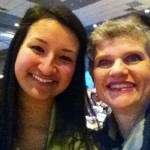As a Baby Boomer, I am becoming increasingly aware of how other people perceive my age group. Seventy-six million strong, Baby Boomers have reshaped the workplace, providing greater opportunities for the generations that follow us. If you are a Baby Boomer and choose to remain in the workplace in the coming years rather than retire, ask yourself: Are you remaining current in your look as a professional? Or are you stuck in the 1980s, still wearing suits with shoulder pads twice the size of your body? If you are, burn them now. Don’t bother donating them to charity because they don’t want them either. It’s time to clean out your closet and update your look. When you remain current and in style, you elevate your level of professionalism.
I recently attended a fun afternoon at a friend’s home, enjoying an image consultant’s presentation. All attendees were asked to bring a favorite jacket or accessory. I chose my favorite robin’s egg blue suit jacket. The little voice inside my head had told me many times that it was outdated, yet, it remained in my closet. Sure enough, I tried it on in front of eight other women and their reaction was clear. “It makes you look old.” Ugh! I then modeled a suit jacket with a more tailored body and shorter cut and voila!…the reaction “WOW! You look fabulous!” resonated throughout the room. I heard the message loud and clear. It’s time to replace the old with the new.
I have seen many Baby Boomers like me in the workplace, wearing clothing that is either outdated or tired looking. The result: The people themselves look outdated. Suits today range in price from affordable $50-$100 new, on sale or at quality resale shops, up to several thousand dollars, depending on your taste (and budget). You can still look like a million dollars with limited funds.
How current are you? Take an afternoon to try on your professional wardrobe in front of a mirror. How does your wardrobe make you look? Youthful? Vibrant? Out of touch? By adding a few fashion forward pieces to your wardrobe each year, including scarves and jewelry for women and new shirts and ties for men, you can take off years from your life.
Now look at your hair style.
Men: If you want to look younger and more attractive, ditch the bad comb-over and shave your head. Yul Brynner started it – shaving his head – in 1951 for the lead role in The King and I and look where it took his acting career. He maintained that look for the rest of his life.
Women: If your hair is big in any way, then it’s stuck in the 80s. Ask your stylist to give you a more current hair cut and style. Do the same with your makeup. What are the current colors? Remember, powder blue eye shadow looked good on Twiggy back in the 1960s (and bright turquoise eye shadow looked good on Mimi on the Drew Carey Show for comic effect only). Ask a professional what make-up complements your coloring.
People will notice the difference in the “new and improved” you. They will most likely ask if you lost weight.
Your outward appearance is one way to demonstrate your level of professionalism. As you mature, remain current in your wardrobe choices so that you look vibrant, vital and stylish. Two questions: What are you doing to enhance your professional look? What simple, inexpensive changes are you making that will help you look more current and in style?
All due respect to David Byrne of the Talking Heads: Nobody wore the “big suit” better than you! I remain a huge fan.
Note: Baby Boomers were born between 1946 and 1964.





